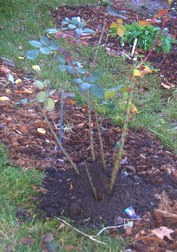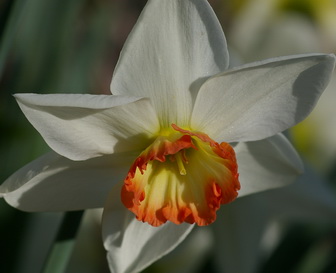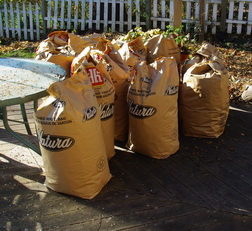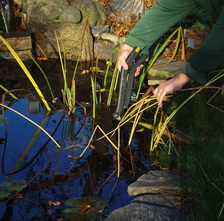


Sometimes the weather gods just smile upon us. This past week, at least where I garden, has been glorious. Warm and sunny and well above normal. That is wonderful because I was way behind on my fall cleanup chores. “Dallying” is a little late for the same reason. The Assistant Gardener and myself decided to check out how to make good hedges from Hibiscus, in case some of my readers need that information, and spent a relaxing week in Bermuda doing just that. We also surveyed the Palm tree population and even checked out the marine vegetation. Yes, the ocean was warm enough for a little salt water frolicking. After returning to a week of cutting, chopping, composting and cleaning this gardener’s body is starting to long for another week in a deck chair.  I am conflicted. There is still much to do and enjoy in this year’s garden. We are still eating a variety of fresh vegetables and I haven’t finished planting the bulbs. The first of next years seed catlogues arrived in the mail this week. I’m forced to just glance at them as I put them out of sight until the snow is deepening and I desperately need a peek at what is to come next spring.
I am conflicted. There is still much to do and enjoy in this year’s garden. We are still eating a variety of fresh vegetables and I haven’t finished planting the bulbs. The first of next years seed catlogues arrived in the mail this week. I’m forced to just glance at them as I put them out of sight until the snow is deepening and I desperately need a peek at what is to come next spring.Am I really putting Rose prunings in the compost in the fall. Yes. I prune the long tops from the Roses, except the couple that were still in bloom, leaving about 50 cm of cane. In my part of the world Roses are a bit difficult and need some winter care. I will throw a shovelful or two of soil around their base to protect the lower part of the canes from the severe cold. The long tops have been pruned down so that they don’t whip around in the wind and disturb the warming soil that is packed around their feet. The real secret to Rose success, actually two secrets, is to plant them deep enough so that the bud union is well below ground and to plant the new hardy varieties that are being bred in cold places like Morden Manitoba. The front page of Gardening-enjoyed has a new look. Every week, if I can keep it up, there should be a new picture illustrating that weeks primary garden activity. You can just go there and see what I’m doing and maybe get a hint about what your own garden activities might include. This is followed by links to new and topical pages that you might find interesting now.  Shirley Asks? Hi, Ken, My question is about the old King Alfred daffodils. Over the years, I've found them to be the only ones that truly naturalize - (regardless of catalogue claims). Multiplying year by year, never needing to be thinned out, shorter stems that don't bend and break in the wind - all in all, a great bulb for the spring garden. I understand that the true King Alfred is no longer available; new hybrids having longer, (weaker) stems and bigger flowers, which cannot withstand the wind - even a breeze! Do you suppose there are any true King Alfred daffs available ANYwhere? If so, I would surely like the info. I have found many packages of daff bulbs claiming to be 'King Alfred type', but they are not the true King Alfred.
.
Shirley Asks? Hi, Ken, My question is about the old King Alfred daffodils. Over the years, I've found them to be the only ones that truly naturalize - (regardless of catalogue claims). Multiplying year by year, never needing to be thinned out, shorter stems that don't bend and break in the wind - all in all, a great bulb for the spring garden. I understand that the true King Alfred is no longer available; new hybrids having longer, (weaker) stems and bigger flowers, which cannot withstand the wind - even a breeze! Do you suppose there are any true King Alfred daffs available ANYwhere? If so, I would surely like the info. I have found many packages of daff bulbs claiming to be 'King Alfred type', but they are not the true King Alfred.
. Ken Answers! It is true that “King Alfred” daffodils are almost impossible to find. Our desire for bigger and better often gets us bigger but not always better in many ways. I have some wonderful sturdy Narcissus that have naturalized well for me but they are not the regular all yellow daffodils. A lovely white with an orange cup, “Flower Record” has performed very well. The all yellow Dutch Master is the best “King Alfred type” that I know of. Claire Aks? Is it too late to pot up some bulbs for winter forcing? Ken Answers! No, it is the perfect time to start potting up some bulbs. Not only is it the right time of year to do so but most of the garden centres will have their bulbs on sale now making it an even better opportunity. 111 Trent St. W. Whitby ON L1N1L9 |

 The delightful warm weather this week has also made one autumn chore much more comfortable. Getting the
The delightful warm weather this week has also made one autumn chore much more comfortable. Getting the 